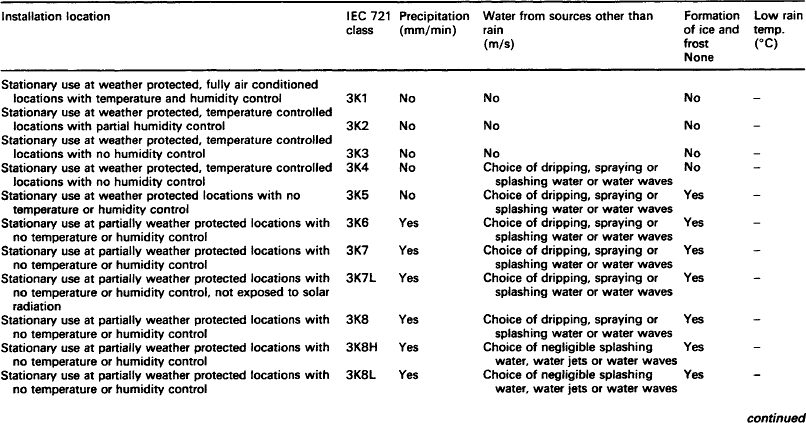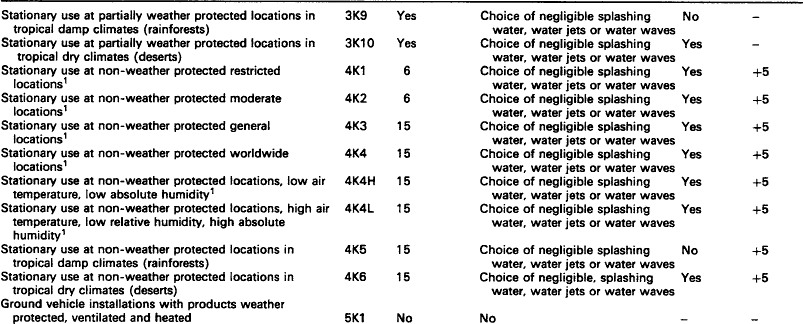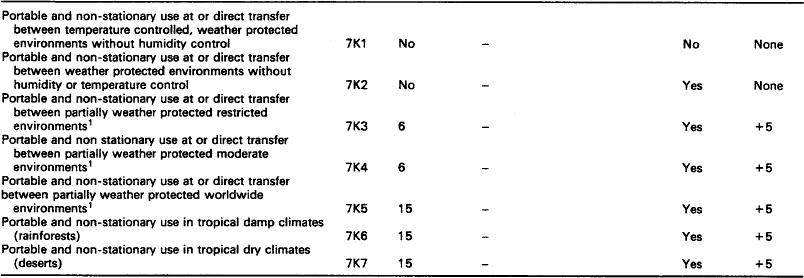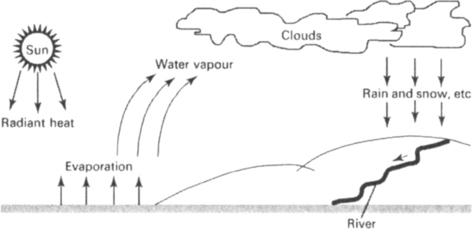Weather and precipitation
6.1 Guidance
6.1.1 What is weather and precipitation?
Water is one of the most remarkable substances on the Earth. It is the substance that we most often see in all its three states: liquid (water), solid (ice) and gas (steam). No living organism can exist without water and as much as half the weight of plants and animals is made up of water. Water in the oceans makes up approximately 11 times the volume of the solid part of the Earth, in addition, that is, to water frozen in ice floes, in lakes, rivers, within the ground and in living plants and animals.
Water is a constantly moving cycle. As the sun beats down, some of the surface water is evaporated; this water vapour rises as part of the air and is moved along by the wind. Should it pass over a land mass it may become a cloud and as more moisture is attracted to the cloud or the clouds pass over rising ground the water particles become larger and fall as rain, sleet or snow. See Figures 6.1. and 6.2.
As the rain comes into contact with the ground there are several avenues open to it; it may be re-vaporised and return to the atmosphere, be absorbed by the ground or remain on the surface of the ground and run downhill forming streams and rivers which run into the sea and the cycle begins once more.
6.1.2 Introduction
Water in all of its three forms is a major cause of failure in every application of electronic components. The humidity of the air and the possible formation of water particles must always be taken into consideration, especially as humidity possesses (almost without exception) a certain amount of electrical conductivity which increases the possibility of corrosion of metals. Similarly, the ingress of water followed by freezing within electronic equipment can result in malfunction.
6.1.2.2 Salt water
Salt has an electrochemical effect on metallic materials (i.e. corrosion) which can damage and degrade the performance of equipment and/or parts that have been manufactured from metallic and/or non-metallic materials. Non-metallic materials can also be damaged by salt through a complex chemical reaction which is dependent on the supply of oxygenated salt solution to the surface of the material, its temperature and the temperature and humidity of the environment. This is particularly a problem in areas close to the sea or mountain ranges.
6.1.2.3 Ice and snow
Water in the form of ice can cause problems in the cooling of equipment, when it freezes and/or thaws in cracks, breaking cases, etc.
Powdered snow can easily be blown through ventilation ducts and then melt down in equipment compartments and cubicles: this can cause damp problems in critical systems if not prevented in the original construction.
6.1.2.4 Weathering
There are several types of weathering.
6.1.2.4.1: Exfoliation During the day rocks are warmed by the sun and at night the surface can cool more rapidly than the underlying rocks. The outer skin of the rock then becomes tight and cracks, thus layers of the rock peel off, making mountains and hills, for example, become rounded or dome shaped. This exfoliation can have an effect on equipment that is sunk into rock faces or mounted on the surface of equipment.
6.1.2.4.2: Freeze thaw When water freezes it turns to ice, expanding by about one-twelfth of its volume. If this water is in the joint or a crack in a casing then the space will become enlarged and the casing on either side will be forced apart. When the ice eventually thaws more water will penetrate into the crack and the cycle repeats itself with the crack constantly enlarging.
6.1.2.4.3: Chemical weathering Water can pick up quantities of sulphur dioxide from the atmosphere and will form a weak solution of acid. This acid can attack certain equipment housings and the process whereby the housing is worn away is known as chemical weathering. Further details of the phenomenon can be found in Chapter 7, Pollutants and contaminants.
6.1.3 Test standards
The primary purpose of water tests is to verify the ability of covers and seals to retain components and equipment in good working order. It may also be used, where necessary, under a standardised dropfield (i.e. water dropping onto the equipment under test conditions).
Tests are also required in order to determine the suitability of a component or a piece of equipment for use (or exposure) in a salt laden atmosphere and to test components or equipment designed to withstand a salt laden atmosphere.
Three basic tests are available. These are:
| IEC 68.2.11 | Environmental testing procedures – Test Ka: Salt mist |
| IEC 68.2.18 | Environmental testing procedures – Test R and guidance: Water |
| IEC 68.5.52 | Environmental testing procedures – Test Kb: Salt mist cyclic (sodium chloride solution) |
6.1.4 Other related standards and specifications
| IEC 34.5 | Rotating electrical machines – Classification of degrees of protection provided by enclosures for rotating machines |
| IEC 68.2.17 | Environmental testing procedures – Test Q: Sealing |
| IEC 68.2.3 | Environmental testing procedures – Test Ca: Damp heat, steady state |
| IEC 144 | Degrees of protection of enclosures for low voltage switchgear and controlgear |
| IEC 529 | Classification of degrees of protection provided by enclosures |
| IEC 721.1 | Classification of environmental conditions – Environmental parameters and their severities |
| IEC 721.2.2 | Classification of environmental conditions – Environmental conditions appearing in nature – Precipitation and wind |
6.2 Typical contract requirements – weather and precipitation
The requirement for equipment to conform to various environmental specifications is becoming commonplace in today’s contracts. More and more specifications are being used to describe the various conditions that equipment is likely to experience when being used, stored or whilst in transit.
The following are the most common environmental requirements found in modern contracts concerning weather and precipitation.
6.2.1 Introduction
Equipment is often exposed to extremes of water and precipitation because of its function. For example, equipment that is operated adjacent to the sea shore or on mountain ranges and therefore subject to water and precipitation must be able to function equally well as the same equipment housed in arid deserts.
6.2.2 Operation
Most contracts will stipulate that ‘all equipment shall be capable of operating during rain, snow, hail and be unaffected by ice, salt and water’. In particular this will concern:
6.2.2.1 Rain
A common contract requirement is that all equipment shall be capable of operating in rain and of preventing the penetration of rainfall at a minimum rate of 13 cm/h and an accompanying wind rate of 25 m/s.
The effect of rain should also be considered dependent on the equipment installation in conjunction with wind and vehicle movement. In these cases the rain rate to be taken into account is normally 6 mm/min (i.e. in accordance with Class 5K3 of IEC 721).
6.2.2.2 Snow and hail
Consideration should be given to the effect of all forms of snow and/or hail. The maximum diameter of the hailstones is conventionally taken as 15 mm, but larger diameters can occur on occasions.
6.2.3 Tests
6.2.3.1 Production configuration
Normally found in contracts is a small notice stating that ‘all proposed candidate equipment, components or other articles shall be tested in their production configuration without the use of any additional external devices that have been added expressly for the purpose of passing water and precipitation testing’.
6.2.3.2 Procuring specification
When tested, the sample (component, equipment or other article) should always perform as stipulated in the procuring specification when subjected to the designated severity of the test.
Test methods for determining the suitability of a specimen shall include:
| IEC 68.2.11 | Environmental testing procedures – Test Ka: Salt mist |
| IEC 62.18 | Environmental testing procedures – Test R and guidance: Water |
| IEC 68.2.52 | Environmental testing procedures – Test Kb: Salt mist cyclic (sodium chloride solution) |
6.3 Values and ranges
Table 6.1
Water and precipitation – storage

1The choice of classification is dependent upon the type of climate in which the equipment will be installed.
Table 6.3
Water and precipitation – operational




1The choice of classification is dependent upon the type of climate in which the equipment will be installed.
6.4 Tests
This section details some of the test standards which may be applied to equipment and contains:
• a list of the most used environmental tests that a purchaser will normally require a manufacturer to adhere to;
Note: Full details of each of these recommended tests are contained in the relevant ISO, IEC or other standard. A complete list of these standards is supplied in the reference section of this book. Copies of all these standards may be obtained from any National Standards Organisation.
6.4.1 Salt mist test (IEC 68.2.11 Test Ka)

6.4.1.1 Introduction
Salt has an electrochemical effect on metallic materials (i.e. corrosion), which can damage and degrade the performance of equipment. Salt can also degrade the performance of parts manufactured using metallic and/or non-metallic materials.
Non-metallic materials can be damaged by salt through a complex chemical reaction which is dependent on the supply of oxygenated salt solution to the surface of the test specimen, the temperature of the specimen and the temperature and humidity of the environment.
6.4.1.3 General
This test is not suitable as a general salt corrosion test or for the evaluation of individual specimens intended for use in salt laden atmospheres. For equipment and components, the tests detailed in IEC 68.2.52 are considered more appropriate as they provide more realistic conditions and enable a simpler form of testing for individual items.
6.4.1.4 Test conditions
IEC 68.2.11 provides details of tests aimed at comparing the resistance to deterioration from salt mist and for evaluating the quality and uniformity of protective coatings.
The salt used for the test shall be high quality sodium chloride with a pH value of solution between 6.5 and 7.2.
The equipment is placed, at a temperature of 35 ± 2°C, in a salt-mist chamber for 2 hours and is then placed in a moist chamber for the specified time. This procedure is then repeated for the specified number of times.
The relevant specification shall indicate the degree of strictness chosen from the range 16 h, 24 h, 2, 4, 14 or 28 days.
6.4.2 Water – falling drops, impacting water and immersion test (IEC 68.2.18 Test R)

6.4.2.1 Introduction
IEC 68.2.18 provides test methods applicable to electrotechnical products which, during transportation, storage or in service, may be subjected to falling drops of water, impacting water or immersion.
The structuring of test methods is shown in Figure 6.4 and is described briefly below.

Fig. 6.4 Structuring of test methods (reproduced from the equivalent standard to BS 2011:PT2.1R(1990) by kind permission of the BSI)
The water tests described in IEC 68.2.18 are structured into three groups:
6.4.2.1.1: Falling drops (Test Ra) Test Ra is a test with artificial rain. It is applicable to all electrotechnical products which during transportation, storage or in service may be exposed to vertical falling drops either from rain, seepage or condensation.
This test is particularly relevant to electrotechnical products that may be placed outdoors and left unprotected from natural rain, or electrotechnical products which, although normally protected from falling rain, may be exposed to falling drops from condensation or leakage from upper surfaces.
Figure 6.5 is an example of the detail provided in Test 68.2.18.
6.4.2.1.2: Impacting water (Test Rb) This test is aimed at considering the effects of water from cloud bursts, heavy driving rain, sprinkler systems, spray from wheels, sluicing or breaking seas.
6.4.2.1.3: Immersion (Test Rc) Test Rc is aimed at electrotechnical products which have been designed to be watertight and which, during transportation or in service, may be subjected to partial or complete submersion.
Test specimens are immersed in water to specified depths and/or equivalent pressures.
6.4.2.2 Purpose of these tests
The purpose of these tests is to verify the ability of covers and seals to maintain components and equipment in good working order under a standardised water dropfield or immersion.
6.4.2.3 General
The tests are intended to embrace all situations where water in liquid form is part of the micro-climate surrounding a product (e.g. rain, drizzle, hosing, immersion but excluding erosion resulting from high velocity water drops).
The range of water tests comprises some new methods based on a defined water intensity together with a number of well-established methods as given in IEC 529.
6.4.2.4 Test conditions
6.4.2.4.1: Test Ra: Falling drops This test is applicable to electrotechnical products which, during transportation, storage or in service may be exposed to vertical falling drops, the origin of these being natural rain, seepage or condensation.
Whether an electrotechnical product tested separately has to function during conditioning or merely to survive conditions shall be clearly stated in the relevant specification.
6.4.2.4.2: Test Rb: Impacting water This test is applicable to all electrotechnical products, which, during transportation, storage or in service, may be subjected to impacting water. The origin of this can be water from cloud bursts, heavy driving rain, sprinkler systems, spray from wheels, sluicing or breaking seas.
Whether an electrotechnical product tested separately has to function during conditioning or merely to survive conditions shall be clearly stated in the relevant specification.
There are a number of tests with Test Rb as follows:
6.4.2.4.2.1: Test Rb1: High intensity dropfield The test specimen is mounted on an appropriate fixture and then subjected to a high intensity drop field.
6.4.2.4.2.2: Test Rb2: Oscillating tube and hand-held showerhead This test is to simulate spray or splashing water, results of water action, or sprinkler systems.
The test specimen is mounted on an appropriate fixture and then subjected to impacting water generated from a semicircular oscillating tube or, if the specimen is too large, a hand-held showerhead is used.
Oscillating tube variant: The severity of the test depends upon the spray nozzle angle, water flow rate, tube oscillating angle and the duration. The values shall be selected from the following tables. There are two variants as shown in Tables 6.4 and 6.5.
Table 6.4
Test Ra1: Artificial rain – test severity

(reproduced from the equivalent standard to BS 2011:PT2.1R(1990) by kind permission of the BSI)
Table 6.5
Test Ra2: Drip box – test severity

(reproduced from the equivalent standard to BS 2011:PT2.1 R(1990) by kind permission of the BSI)
Note: Alternatively the tube oscillating arrangement α = 60° and β = 60° can be replaced by a fixed nozzle angle semicircular tube under which the test specimen is rotated.
6.4.2.4.2.3: Test Rb3: Hosing The test specimen is subjected to hosed water which is aimed at simulating wheel spray, sluicing or breaking seas. The severity of the test depends upon the choice of test nozzle, size, sluicing distance and test duration as shown below.
Table 6.10
Test Rb: Hosing – test severity – flow rates and nozzles

(reproduced from the equivalent standard to BS 2011:PT2.1R(1990) by kind permission of the BSI)
The distance from the nozzle to the specimen shall be 2.5 ± 0.05 m.
This distance may be reduced if necessary to ensure proper wetting when spraying upwards. At a distance of 2.5 m from the nozzle the substantial part of the water jet shall be within a circle of 40 mm for the 6.3 mm nozzle and 100 mm for the 12.5 mm nozzle.
6.4.2.4.3: Test Rc: Immersion This test is applicable to electrotechnical products which are designed to be watertight and which, during transportation or while in service, may be subjected to partial or complete immersion. Whether an electrotechnical product tested separately has to function during conditioning or merely to survive conditions shall be clearly stated in the relevant specification.
There are two tests associated with Test Rc, as follows:
6.4.2.4.3.1: Test Rc1: Water tank The test specimen is subjected to a specified pressure by immersion in a water tank at a specified depth.
6.4.2.4.3.2: Test Rc2: Pressurised water chamber The test specimen is subjected to a specified pressure by immersion in a pressurised water chamber.
Table 6.13
Test Rc2: Pressurised water chamber – test severity

(reproduced from the equivalent standard to BS 2011:PT2.1 R(1990) by kind permission of the BSI)
Table 6.14
Summary of test characteristics


(reproduced from the equivalent standard to BS 2011:PT2.1R(1990) by kind permission of the BSI)
6.4.3 Sart mist (cyclic) test (IEC 68.2.52 Test Kb)

6.4.3.1 Introduction
Salt has an electrochemical effect on metallic materials (i.e. corrosion), which can damage and degrade the performance of equipment. Salt can also degrade the performance of parts manufactured using metallic and/or non-metallic materials.
Non-metallic materials can also be damaged by salt through a complex chemical reaction (dependent on the supply of oxygenated salt solution to the surface of the test specimen), the temperature of the specimen and the temperature and humidity of the environment.
6.4.3.3 General
Test specimens are not energised during the spraying method and not normally during the storage period.
This test is accelerated compared with most service conditions.
6.4.3.4 Test conditions
IEC 68.2.52 provides details of the salt mist (cyclic) test aimed at evaluating the suitability of components and/or equipment being used in (or exposed to) a salt laden atmosphere.
The test procedure consists of spraying the components/equipment with a 5% sodium chloride (NaCl) salt mist solution for a specified time which is then followed by storage at a humid temperature of 40°C with 93% relative humidity.
The severity of the test is defined by the combination of the number of spraying periods and the duration of the storage under humid conditions following each spray.












